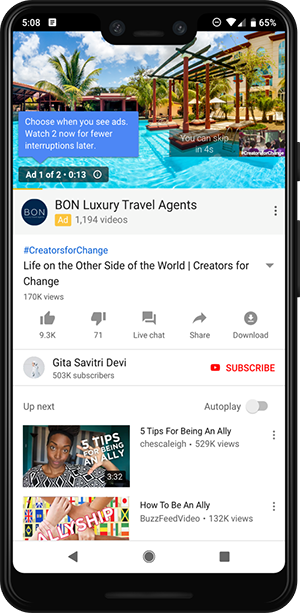Subscribe now and get the latest podcast releases delivered straight to your inbox.
YouTube Launching Ad Pods to Limit Disruption But Keep Advertisers Happy

Nov 29, 2018

As a consumer, I grew up with the frustration of long, strung-together commercial breaks right in the middle of a climactic scene right in the middle of my favorite TV show.
These same advertising methods have now even moved online with sudden ad “breaks” as we watch videos on YouTube.
It’s frustrating and Google recognizes that now too.
In fact, recent research from Google-owned YouTube concluded that “viewers are quite sensitive to the frequency of ad breaks, especially during longer viewing sessions.”
When ads interrupted videos longer in length at various points throughout video, users tended to bounce off the video and lose interest. This didn’t bode well for YouTube, advertisers, or content creators.
With these findings, YouTube has been working to solve the viewer sensitivity issue while still maintaining ad space for revenue.
So, how can they continue their ad revenue while at the same time keeping their viewers happy? And what does it mean for you?
The Solution: Ad Pods
Ad Pods are a new advertising move by YouTube in which two video ads are shown in succession, while still allowing viewers to skip directly to the content if it’s not the right ad for them.
What makes Ad Pods so great is that by stacking the ads at the beginning of a video, there will be fewer interruptions in the middle of a longer-form video.
For example, instead of a user being interrupted by ads in four different places during a video by four different ads, they will now experience only two interruptions with two ads played during each break.
It’s important to note that there are a few iterations of an Ad Pod that users may experience and it doesn’t mean they’ll get out of watching ads completely.
AdAge explains, in Ad Pods, “[t]here is a skippable ad followed by a six-second ad, and if the viewer skips the first ad after five seconds, then the second ad won't run either. The six-second, unskippable ad can also run before the skippable ad. Finally, viewers might encounter two six-second, unskippable ads.”
While some of the Ad Pod iterations appear more tolerable than others, most allow some form of ad-skipping.
This is essential as advertisers are paying good money for their ads to be seen and, moreover, consumers are less tolerable to viewing ads in general as ad-free video streaming services like Netflix and HBO have gained popularity.

YouTube has begun introducing the stacked Ad Pods on desktop with future releases to mobile and TV screens coming soon.
The announcement states that the intention of the Ad Pods is to “accommodate viewer preferences while continuing to help advertisers connect with their most important audiences.”
How Will Marketers Benefit?
With the early release testing of Ad Pods, Google found an “8-11 percent increase in unique reach and a 5-10 percent increase in frequency for advertisers, with no impact to Brand Lift metrics.”
As a marketer, the increase in unique reach allows your ad to reach more individuals in your target audience.
Marketers can now further their strategy by pairing Ad Pods with TrueView In-Stream Ads. With TrueView companies can present an educational element in the first ad with the second prompting more interaction such as a call-to-action to provide valuable content directly to the user.
This arrangement nurtures and educates the viewer into becoming a more highly-qualified lead/viewer and allows for a more inbound marketing experience in which the user feels empowered make the decision to engage with a company’s offer rather feeling sold to.
But YouTube Wins As Well
Marketers and the companies they market for are not the only ones beneftting in this new ad structure; YouTube wins as well.
Jason Linde, IMPACT’s Paid Media Specialist shares:
"This is a win-win for YouTube... they help the viewers with less disruption in their video watching experience by stacking the adsand [they help themselves] because they don't have to limit the number of Ads [they show] in this scenario….[A]lsowith the idea of front-loading the ads, users could lean more towards [a] paid subscription [to YouTube] to avoid this...."
What To Expect
Ad Pods will begin to appear when viewing YouTube and partner platforms on desktop with expansion into mobile and streaming platforms following in 2019.
Consumers will begin to see more relevant ads to the videos they are viewing and recent searches they have made. As mentioned above, this is also a huge benefit to marketers as unique reach has been found to increase from the ad pods providing more value per ad spend.
Next Steps
If you haven’t started working video into your marketing strategy, the gradual release of this feature gives you a little bit time to get on board!
Not sure where to start? Check out this article to learn the Anatomy of a Successful Social Video Ad!
Free: Assessment